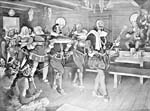|
The 1000-year-old Norse settlement at l'Anse aux Meadows in Newfoundland marks the earliest site of European cooking in Canada. However, Canadian culinary history would not be influenced by European adaptations until 1605, when the Habitation at Port-Royal was founded in Acadia (Nova Scotia). The first winters at Port-Royal were long and difficult for the settlers. At the height of the cold weather in 1606-7, Samuel de Champlain proposed that a social club, The Order of Good Cheer, be established to keep the men's spirits up.
Each night one of the men would plan and prepare the food for the banquet. There was lots of wine to accompany the meal, and much singing and merriment among those present. The entertainment at one of these banquets, The Theatre of Neptune by Marc Lescarbot, is considered to be the first formal play written and produced in North America.
The Mi'kmaq were invited to the feasts, and they supplied most of the fresh food. We don't have a record of the menus, but we know that the region's plentiful game and fish would have provided the main ingredients. Hippocras, a favourite drink of the period, was served at the end of the meal. A recipe for hippocras (to be served warm) includes the following ingredients: 4.5 litres of red wine, 1 litre of white sugar, 1 stick of cinnamon, 6 peppercorns, 6 teaspoons of nutmeg, 24 cloves, 2 teaspoons of ground ginger and a cup of orange blossom water.
|
 Source
Source
|
|
|
Watercolour of the Order of Good Cheer by C.W. Jefferys
|
|